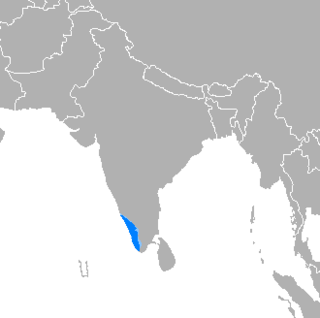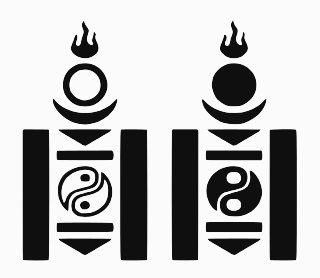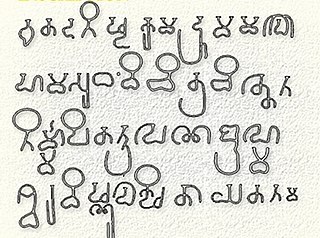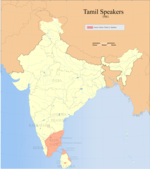
The Arabic alphabet, or Arabic abjad, is the Arabic script as specifically codified for writing the Arabic language. It is written from right-to-left in a cursive style, and includes 28 letters, of which most have contextual letterforms. The Arabic alphabet is considered an abjad, with only consonants required to be written; due to its optional use of diacritics to notate vowels, it is considered an impure abjad.
In mathematics and computing, the hexadecimal numeral system is a positional numeral system that represents numbers using a radix (base) of sixteen. Unlike the decimal system representing numbers using ten symbols, hexadecimal uses sixteen distinct symbols, most often the symbols "0"–"9" to represent values 0 to 9, and "A"–"F" to represent values from ten to fifteen.

Malayalam is a Dravidian language spoken in the Indian state of Kerala and the union territories of Lakshadweep and Puducherry by the Malayali people. It is one of 22 scheduled languages of India. Malayalam was designated a "Classical Language of India" in 2013. Malayalam has official language status in Kerala and Puducherry (Mahé), and is also the primary spoken language of Lakshadweep and is spoken by 34 million people in India. Malayalam is also spoken by linguistic minorities in the neighbouring states; with a significant number of speakers in the Kodagu and Dakshina Kannada districts of Karnataka, and Kanyakumari and Nilgiris district of Tamil Nadu. It is also spoken by the Malayali Diaspora worldwide, especially in the Persian Gulf countries, due to the large populations of Malayali expatriates there. They are a significant population in each city in India including Mumbai, Bengaluru, Delhi, Kolkata, Pune etc. Malayalam is closely related to the Tamil language.

The Sinhala script, also known as Sinhalese script, is a writing system used by the Sinhalese people and most Sri Lankans in Sri Lanka and elsewhere to write the Sinhala language as well as the liturgical languages Pali and Sanskrit. The Sinhalese Akṣara Mālāva, one of the Brahmic scripts, is a descendant of the Ancient Indian Brahmi script. It is also related to the Grantha script.

The Brahmic scripts, also known as Indic scripts, are a family of abugida writing systems. They are used throughout the Indian subcontinent, Southeast Asia and parts of East Asia. They are descended from the Brahmi script of ancient India and are used by various languages in several language families in South, East and Southeast Asia: Indo-Aryan, Dravidian, Tibeto-Burman, Mongolic, Austroasiatic, Austronesian, and Tai. They were also the source of the dictionary order (gojūon) of Japanese kana.
The Thai script is the abugida used to write Thai, Southern Thai and many other languages spoken in Thailand. The Thai alphabet itself has 44 consonant symbols and 16 vowel symbols that combine into at least 32 vowel forms and four tone diacritics to create characters mostly representing syllables.

Malayalam script is a Brahmic script used commonly to write Malayalam, which is the principal language of Kerala, India, spoken by 45 million people in the world. It is a Dravidian language spoken in the Indian state of Kerala and the union territories of Lakshadweep and Puducherry by the Malayali people. It is one of the official scripts of the Indian Republic. Malayalam script is also widely used for writing Sanskrit texts in Kerala.

The Soyombo script is an abugida developed by the monk and scholar Zanabazar in 1686 to write Mongolian. It can also be used to write Tibetan and Sanskrit.
The Balinese script, natively known as Aksara Bali and Hanacaraka, is an abugida used in the island of Bali, Indonesia, commonly for writing the Austronesian Balinese language, Old Javanese, and the liturgical language Sanskrit. With some modifications, the script is also used to write the Sasak language, used in the neighboring island of Lombok. The script is a descendant of the Brahmi script, and so has many similarities with the modern scripts of South and Southeast Asia. The Balinese script, along with the Javanese script, is considered the most elaborate and ornate among Brahmic scripts of Southeast Asia.

The Tamil script is an abugida script that is used by Tamils and Tamil speakers in India, Sri Lanka, Malaysia, Singapore, Indonesia and elsewhere to write the Tamil language. It is one of the official scripts of the Indian Republic. Certain minority languages such as Saurashtra, Badaga, Irula and Paniya are also written in the Tamil script.

The zero-width non-joiner () is a non-printing character used in the computerization of writing systems that make use of ligatures. When placed between two characters that would otherwise be connected into a ligature, a ZWNJ causes them to be printed in their final and initial forms, respectively. This is also an effect of a space character, but a ZWNJ is used when it is desirable to keep the characters closer together or to connect a word with its morpheme.
Lao script or Akson Lao is the primary script used to write the Lao language and other minority languages in Laos. Its earlier form, the Tai Noi script, was also used to write the Isan language, but was replaced by the Thai script. It has 27 consonants, 7 consonantal ligatures, 33 vowels, and 4 tone marks.

Iteration marks are characters or punctuation marks that represent a duplicated character or word.

The Grantha script was a classical South-Indian script, found particularly in Tamil Nadu and Kerala. Originating from the Pallava script, the Grantha script is related to Tamil and Vatteluttu scripts. The modern Malayalam script of Kerala is a direct descendant of the Grantha script. The Southeast Asian and Indonesian scripts such as Thai and Javanese respectively, as well as South Asian Tigalari and Sinhala scripts, are derived or closely related to Grantha through the early Pallava script. The Pallava script or Pallava Grantha, emerged in the 4th century CE and was used until the 7th century CE, in India. This early Grantha script was used to write Sanskrit texts, inscriptions on copper plates and stones of Hindu temples and monasteries. It was also used for classical Manipravalam – a language that is a blend of Sanskrit and Tamil. From it evolved Middle Grantha by the 7th century, and Transitional Grantha by about the 8th century, which remained in use until about the 14th century. Modern Grantha has been in use since the 14th century and into the modern era, to write classical texts in Sanskrit and Dravidian languages. It is also used to chant hymns and in traditional Vedic schools.

The Ukrainian alphabet is the set of letters used to write Ukrainian, which is the official language of Ukraine. It is one of several national variations of the Cyrillic script. It comes from the Cyrillic script, which was devised in the 9th century for the first Slavic literary language, called Old Slavonic. In the 10th century, it became used in Kievan Rus' to write Old East Slavic, from which the Belarusian, Russian, Rusyn, and Ukrainian alphabets later evolved. The modern Ukrainian alphabet has 33 letters in total: 20 consonants, 2 semivowels, 10 vowels and 1 palatalization sign. Sometimes the apostrophe (') is also included, which has a phonetic meaning and is a mandatory sign in writing, but is not considered as a letter and is not included in the alphabet.

Mandombe or Mandombé is a script proposed in 1978 in Mbanza-Ngungu in the Bas-Congo province of the Democratic Republic of the Congo by Wabeladio Payi, who related that it was revealed to him in a dream by Simon Kimbangu, the prophet of the Kimbanguist Church. Mandombe is based on the sacred shapes and , and intended for writing African languages such as Kikongo, as well as the four national languages of the Congo, Kikongo ya leta, Lingala, Tshiluba and Swahili, though it does not have enough vowels to write Lingala fully. It is taught in Kimbanguist church schools in Angola, the Republic of the Congo, and the Democratic Republic of the Congo. It is also promoted by the Kimbanguist Centre de l’Écriture Négro-Africaine (CENA). The Mandombe Academy at CENA is currently working on transcribing other African languages in the script. It has been classified as the third most viable indigenous script of recent indigenous west African scripts, behind only the Vai syllabary and the N'Ko alphabet.
Tamil phonology is characterised by the presence of "true-subapical" retroflex consonants and multiple rhotic consonants. Its script does not distinguish between voiced and unvoiced consonants; phonetically, voice is assigned depending on a consonant's position in a word, voiced intervocalically and after nasals except when geminated. Tamil phonology permits few consonant clusters, which can never be word initial.
A numeral is a character that denotes a number. The decimal number digits 0–9 are used widely in various writing systems throughout the world, however the graphemes representing the decimal digits differ widely. Therefore Unicode includes 22 different sets of graphemes for the decimal digits, and also various decimal points, thousands separators, negative signs, etc. Unicode also includes several non-decimal numerals such as Aegean numerals, Roman numerals, counting rod numerals, Mayan numerals, Cuneiform numerals and ancient Greek numerals. There is also a large number of typographical variations of the Western Arabic numerals provided for specialized mathematical use and for compatibility with earlier character sets, such as ² or ②, and composite characters such as ½.
The rupee sign "₨" is a currency sign used to represent the monetary unit of account in Pakistan, Sri Lanka, Nepal, Mauritius, Seychelles, and formerly in India. It resembles, and is often written as, the Latin character sequence "Rs", of which it is an orthographic ligature.
Extended-Tamil script or Tamil-Grantha refers to a script used to write the Tamil language before the 20th century Tamil purist movement. Tamil-Grantha is a mixed-script: a combination of the conservative-Tamil script that independently evolved from pre-Pallava script, combined with consonants imported from a later-stage evolved Grantha script to write non-Tamil consonants. Some scholars posit that the origin of Tamil-Grantha is unclear: the script could also be a direct descendant of the Pallava-Grantha script which extensively developed during the Middle Tamil period to write Middle-Tamil.














